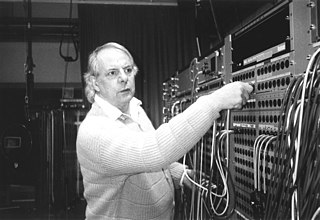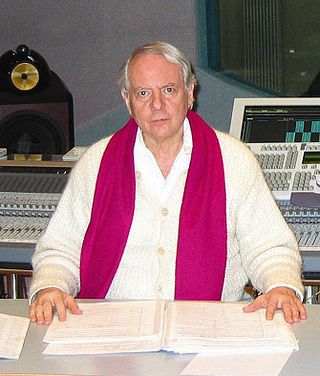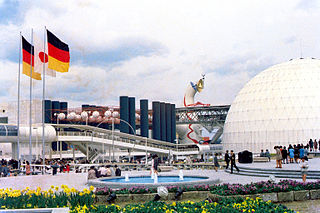
Karlheinz Stockhausen was a German composer, widely acknowledged by critics as one of the most important but also controversial composers of the 20th and early 21st centuries. He is known for his groundbreaking work in electronic music, having been called the "father of electronic music", for introducing controlled chance into serial composition, and for musical spatialization.

Gesang der Jünglinge is an electronic music work by Karlheinz Stockhausen. It was realized in 1955–56 at the Westdeutscher Rundfunk studio in Cologne and is Work Number 8 in the composer's catalog. The vocal parts were supplied by 12-year-old Josef Protschka. It is exactly 13 minutes, 14 seconds long.

Inori, for one or two soloists with orchestra, is a composition by Karlheinz Stockhausen, written in 1973–74.
David C. Johnson was an American composer, flautist, and performer of live electronic music.
Gruppen for three orchestras (1955–57) is amongst the best-known compositions of German composer Karlheinz Stockhausen, and is Work Number 6 in the composer's catalog of works. Gruppen is "a landmark in 20th-century music ... probably the first work of the post-war generation of composers in which technique and imagination combine on the highest level to produce an undisputable masterpiece".
Herbert Eimert was a German music theorist, musicologist, journalist, music critic, editor, radio producer, and composer.

Kontakte is an electronic music work by Karlheinz Stockhausen, realized in 1958–60 at the Westdeutscher Rundfunk (WDR) electronic-music studio in Cologne with the assistance of Gottfried Michael Koenig. The score is Nr. 12 in the composer's catalogue of works, and is dedicated to Otto Tomek.

The Klavierstücke constitute a series of nineteen compositions by German composer Karlheinz Stockhausen.

Hymnen is an electronic and concrete work, with optional live performers, by Karlheinz Stockhausen, composed in 1966–67, and elaborated in 1969. In the composer's catalog of works, it is No. 22.

Klang —Die 24 Stunden des Tages is a cycle of compositions by Karlheinz Stockhausen, on which he worked from 2004 until his death in 2007. It was intended to consist of 24 chamber-music compositions, each representing one hour of the day, with a different colour systematically assigned to every hour. The cycle was unfinished when the composer died, so that the last three "hours" are lacking. The 21 completed pieces include solos, duos, trios, a septet, and Stockhausen's last entirely electronic composition, Cosmic Pulses. The fourth composition is a theatre piece for a solo percussionist, and there are also two auxiliary compositions which are not part of the main cycle. The completed works bear the work (opus) numbers 81–101.

Mixtur, for orchestra, 4 sine-wave generators, and 4 ring modulators, is an orchestral composition by the German composer Karlheinz Stockhausen, written in 1964, and is Nr. 16 in his catalogue of works. It exists in three versions: the original version for full orchestra, a reduced scoring made in 1967, and a re-notated version of the reduced scoring, made in 2003 and titled Mixtur 2003, Nr. 162⁄3.
Studie I is an electronic music composition by Karlheinz Stockhausen from the year 1953. It lasts 9 minutes 42 seconds and, together with his Studie II, comprises his work number ("opus") 3.
The Konkrete Etüde is the earliest work of electroacoustic tape music by Karlheinz Stockhausen, composed in 1952 and lasting just three-and-a-quarter minutes. The composer retrospectively gave it the number "1⁄5" in his catalogue of works.
Nummer 5 met zuivere tonen is a musical work by the Belgian composer Karel Goeyvaerts, realized at the WDR Studio for Electronic Music in 1953 and one of the earliest pieces of electronic music.

Harlekin (Harlequin) is a composition for unaccompanied clarinet by Karlheinz Stockhausen, named for the commedia dell'arte character Harlequin. It was composed in 1975 and is Number 42 in his catalogue of works. A shorter, derived work called Der kleine Harlekin is Number 42½.

Stop is a composition for orchestra by Karlheinz Stockhausen, work-number 18 in the composer’s catalogue of works, where two performing realisations are also found as Nr. 18½ and Nr. 18⅔.

Oktophonie (Octophony) is a 1991 octophonic electronic-music composition by Karlheinz Stockhausen. A component layer of act 2 of the opera Dienstag aus Licht, it may also be performed as an independent composition. It has a duration of 69 minutes.

Expo, for three performers with shortwave radio receivers and a sound projectionist, is a composition by Karlheinz Stockhausen, written in 1969–70. It is Number 31 in the catalogue of the composer's works.
In music, the Cologne School is a loosely associated group of composers and performers of the generation that came to prominence in the 1970s, who lived and worked in the city of Cologne, Germany.

The Studio for Electronic Music of the West German Radio was a facility of the Westdeutscher Rundfunk (WDR) in Cologne. It was the first of its kind in the world, and its history reflects the development of electronic music in the second half of the twentieth century.














